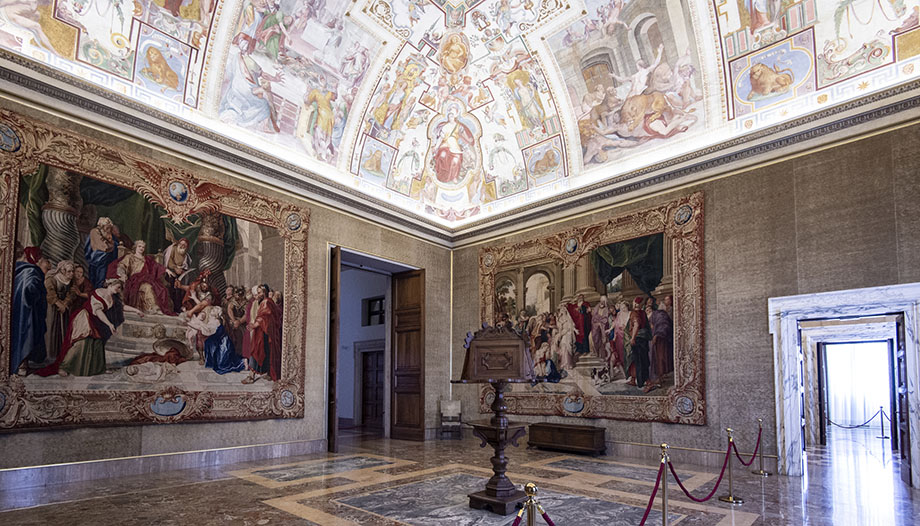Translation of the article into Italian
Art, culture and faith. The Lateran Palace is a treasure that spans more than three centuries of Christian history. In the heart of the Eternal City, next to the Basilica of St. John Lateran, it has always been the "Mother and Head" of all the churches of Rome and the world.
Still today, the Pope, bishop of Rome, takes "physical" possession of his diocese by going precisely to the cathedral of St. John Lateran.
Since December 13 of last year, the Lateran Palace has opened its doors to the public with a unique and innovative layout that runs through the second floor of the Apostolic Palace. Here visitors are spellbound by the majesty of the ten rooms - including the one in which the Lateran Pacts were signed - which display 16th century frescoes, fine tapestries, paintings by great artists and precious antique furnishings. These were the places of representation of the Popes who lived in the complex for over 1000 years. After passing through them, one enters the private apartments of the Holy Father, which, together with the chapel, can now be visited for the first time in its history.
The Missionary Sisters of Divine Revelation, committed to evangelization through beauty, accompany the visitor along the tour. The tour ends inside the Basilica of St. John Lateran with access to the majestic monumental staircase.
It was Pope Francis who suggested revitalizing what for centuries was the "House of the Bishop of Rome" before it was moved to the Vatican. In a letter dated February 20, 2021, addressed to Cardinal Vicar Angelo De Donatis, the Holy Father invited to share the "fruit of the genius and mastery of artists, often testimony to experiences of faith" and to "make usable the beauty and prominence of the patrimony and artistic assets" entrusted to the protection of the Bishop of Rome.
History of the Lateran Palace
To retrace the history of the Lateran PalaceThe date back to October 28, 312, when Constantine's troops defeated Maxentius in the famous battle of Ponte Milvio. On the throne of Peter then sat Pope Miltiades I, to whom Constantine donated the area and the buildings that once belonged to the ancient Lateran family.
It was Constantine himself who, with the Edict of Milan in 313, granted freedom of worship to Christians who, until then, had professed their faith in the midst of intolerance and persecution, and promoted the construction of places for the profession of faith.
The Basilica of the Most Holy Savior, which would later also be dedicated to Saints Baptist and Evangelist, was the only one that was not built on the burial place of a martyr, but rather as a ex voto suscepto (by grace received), on the remains of the Castra Nova Equitum singulariumIt was the headquarters of the Praetorians of Constantine's rival, Maxentius. The basilica was consecrated on November 9, 318 and was dedicated to the Holy Savior by Pope Sylvester I. In addition to the Baptistery, the Patriarchium, known as the "House of the Bishop of Rome", was later annexed.
Over the centuries, amidst damage, vicissitudes and looting, these places knew their greatest splendor in medieval times, under the papacy of Innocent III and Boniface VIII.
Transfer to the Vatican
The Palace served as the residence of the Popes for about a thousand years, but was abandoned when the papal authority returned after the "Avignon Captivity" (1309-1377). In fact, the Vatican was designated as the place chosen to house the Pope, not only because of the geographical aspects that made it safer, but especially because of the presence of Peter's tomb. Despite this, the Palace would continue to maintain its prerogative of Patriarchate: all Popes, in fact, once elected to the papal throne, would take up residence in the Lateran.
The urban redevelopment of the entire complex took place at the behest of Pope Sixtus V (1585-1590), who carried out, in just five years of his pontificate, a series of restructuring and construction operations in the surrounding area and throughout the city. In the end, however, Sixtus V could only stay in the Lateran for one year and all his successors chose the Vatican as their home.
But the importance of the place was maintained over the centuries. The Lateran palace would rarely be used as a dwelling. Its primary use was as a "begging house" to provide a place for the city's poor to live and work.
It was then, with the figures of Gregory XVI, Pius IX and Pius XI, that it was destined to house the documents and historical memories related to the universal propagation of the Gospel.
John XXIII first, and Paul V later, carried out an extensive remodeling and restoration of the Palace, which ended in 1967 with the transfer of the offices of the Vicariate of Rome.
Today it is only possible to access the Lateran Palace with guided tours, in groups of a maximum of 30 people. To book, just choose the desired date at www.palazzolateranense.com








